| Notes: The West Midlands Railway (WMR) was formed on 14 June 1860 with the union of the Oxford, Worcester & Wolverhampton Railway (OW&WR) and the Newport, Abergavenny & Hereford Railway (NA&HR).
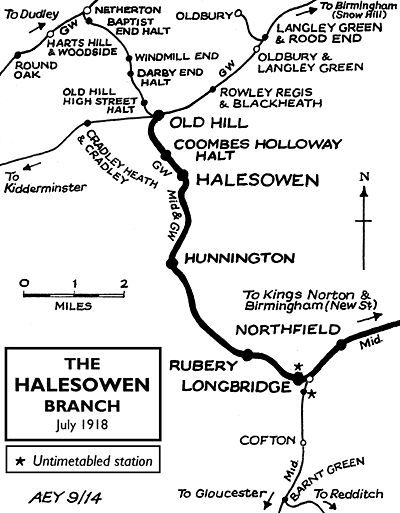 In its efforts to reach industrial Birmingham, the WMR obtained an Act of Parliament to build a line from Stourbridge Junction to Old Hill, and within 12 months had obtained a second Act to complete the line from Old Hill to the London & North Western Railway’s (LNWR) Stour Valley line at Smethwick with an adjoining link to the Great Western Railway’s (GWR) line from Snow Hill to Wolverhampton Low Level near Handsworth. On 17 July 1862 the WMR Additional Works Act authorised the construction of two branches radiating from Old Hill. The first was to run in a northerly direction to Blowers Green Junction, near Dudley, and connect with the GWR’s Stourbridge Junction to Wolverhampton Low Level line. The second would run south to Halesowen with an end-on connection with the proposed Halesowen & Bromsgrove Branch Railway (HB&BR). On 1 August 1863 the WMR was amalgamated with the GWR: a shrewd move by the GWR as it would deny the LNWR access via Smethwick to Stourbridge and allow direct access to Birmingham. In the 1860s any trains from the Stourbridge direction wishing to access Birmingham had to travel via Dudley and reverse at Wolverhampton Low Level, substantially increasing the journey time. In its efforts to reach industrial Birmingham, the WMR obtained an Act of Parliament to build a line from Stourbridge Junction to Old Hill, and within 12 months had obtained a second Act to complete the line from Old Hill to the London & North Western Railway’s (LNWR) Stour Valley line at Smethwick with an adjoining link to the Great Western Railway’s (GWR) line from Snow Hill to Wolverhampton Low Level near Handsworth. On 17 July 1862 the WMR Additional Works Act authorised the construction of two branches radiating from Old Hill. The first was to run in a northerly direction to Blowers Green Junction, near Dudley, and connect with the GWR’s Stourbridge Junction to Wolverhampton Low Level line. The second would run south to Halesowen with an end-on connection with the proposed Halesowen & Bromsgrove Branch Railway (HB&BR). On 1 August 1863 the WMR was amalgamated with the GWR: a shrewd move by the GWR as it would deny the LNWR access via Smethwick to Stourbridge and allow direct access to Birmingham. In the 1860s any trains from the Stourbridge direction wishing to access Birmingham had to travel via Dudley and reverse at Wolverhampton Low Level, substantially increasing the journey time.

Construction of the main line from Stourbridge Junction had reached Old Hill by 1866, with some sources reporting that a temporary station had opened near Old Hill at that time. The further extensions to the LNWR at Smethwick Junction and the GWR line near Handsworth were opened on 1 April 1867 along with the station at Old Hill. Construction of the branch lines continued and both would opened on 1 March 1878 making Old Hill an important junction; the station had been constructed with this in mind. The up (Birmingham direction) platform was single-faced and of considerable length. The down platform was of a similar length but a branch platform behind it curved away to Halesowen, thus giving it a triangular shape. Platform facilities were befitting of an important junction station, although the design of the buildings was austere. The principal building, on the up (north) platform, was approached by a flight of steps. Although two-storeys in height, in order to serve the elevated platform, the office and waiting facilities were in the upper storey timber structure at platform level, whilst the lower storey was of brick. The roof was half-hipped, and above the western office section it was slightly higher than to the east; the slope of the roof was extended a little to form a small porch over the entrance to the booking hall. A flat awning, supported by a series of pillars and undecorated brackets, extended from the building to the platform edge, and its valance was provided with deep serrations on each end and a shallower, undecorated front. At the western end of the station a covered footbridge connected the platforms, but in later years the roofing was removed. The triangular plan of the other island/junction platform was repeated in the unassuming, single-storey building upon it which was concealed behind awnings of the same pattern as on the northern platform. The signal box, containing 40 levers, was on the triangular platform, at its western end and tucked behind the passenger building. Within 20 years the signal box was replaced with a GWR type 27a with a 49-lever GWR Twist Frame. The signal box nameplate was ordered from Reading Signal Works on 15 January 1897 to read ‘OLD HILL JUNCTION’. The box was aligned at right angles to the main line.
Operation of such a busy junction station must have been no mean feat, with 70 arrivals and  departures on Monday-to-Saturday and 10 on a Sunday as shown in Bradshaw’s 1895 timetable. Having their own platform, Halesowen trains operated independently from those on the main line. On the other hand, services to Dudley via Windmill End would arrive at the main up platform and have to be switched to the main down platform without disrupting the intensive service between Stourbridge Junction and Birmingham. Freight seems not to have been a major concern for the GWR, although a trailing connection from the up main line was laid at the Birmingham end of the platform with a short siding laid close to the already well established canal basin. The yard never developed and the track into it was clearly out of use by the early 1950s. departures on Monday-to-Saturday and 10 on a Sunday as shown in Bradshaw’s 1895 timetable. Having their own platform, Halesowen trains operated independently from those on the main line. On the other hand, services to Dudley via Windmill End would arrive at the main up platform and have to be switched to the main down platform without disrupting the intensive service between Stourbridge Junction and Birmingham. Freight seems not to have been a major concern for the GWR, although a trailing connection from the up main line was laid at the Birmingham end of the platform with a short siding laid close to the already well established canal basin. The yard never developed and the track into it was clearly out of use by the early 1950s.
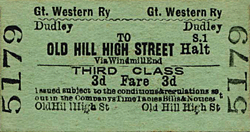 Rationalisation of the passenger service came on 5 December 1927 when the GWR withdrew the Halesowen trains; although all was not lost with two unadvertised workmen’s return trains to the Austin plant at Longbridge. It was not unknown for members of the public also to use the trains, which were eventually discontinued on 29 August 1958. Since 1 February that year the Halesowen branch had been transferred from British Railways Western Region to London Midland administration, although Old Hill station itself remained in the Western Region. Rationalisation of the passenger service came on 5 December 1927 when the GWR withdrew the Halesowen trains; although all was not lost with two unadvertised workmen’s return trains to the Austin plant at Longbridge. It was not unknown for members of the public also to use the trains, which were eventually discontinued on 29 August 1958. Since 1 February that year the Halesowen branch had been transferred from British Railways Western Region to London Midland administration, although Old Hill station itself remained in the Western Region.
Some limited modernisation of the station was carried out by British Railways Western Region after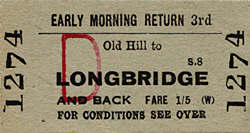 1957 when their fully flanged totem nameplates were installed; however they were fixed to elderly gas lamps of an elegant GWR design with slender metal scrolls above the lamp bracket. Platform seats bearing the earlier GWR logo on the supports continued to meet the needs of weary passengers. Some exquisite GWR running-in nameboards were retained into the 1960s; not content with giving the station’s name, they invited passengers to change for Halesowen, Windmill End branch and Dudley – despite the withdrawal of the regular Halesowen service over three decades earlier. 1957 when their fully flanged totem nameplates were installed; however they were fixed to elderly gas lamps of an elegant GWR design with slender metal scrolls above the lamp bracket. Platform seats bearing the earlier GWR logo on the supports continued to meet the needs of weary passengers. Some exquisite GWR running-in nameboards were retained into the 1960s; not content with giving the station’s name, they invited passengers to change for Halesowen, Windmill End branch and Dudley – despite the withdrawal of the regular Halesowen service over three decades earlier.
A further major revision of British Railways regional boundaries took place on 1 January 1963 when the main line through Old Hill to a point between Hartlebury and Droitwich Spa (including the Old Hill-Dudley branch) was transferred to the London Midland Region. The next change to the 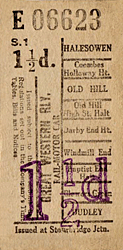 passenger service was the withdrawal of the service to Dudley on 15 June 1964, as recommended in the ‘Beeching Report’ of March 1963. This was to have a massive impact on the station facilities. The first rationalisation was the demolition of the down (Stourbridge direction) platform buildings and the long, curving platform on the Halesowen branch. Passengers travelling south-west, to stations such as Cradley Heath, Lye or Stourbridge, were not even provided with a waiting shelter. The signal box on the down side survived until a re-signalling project in the early 1970s saw its abolition. The now shabby and neglected buildings on the up (Birmingham direction) platforms would also be demolished in the late 1960s, being replaced with a charmless, utilitarian single-storey building resembling a public convenience. Fluorescent electric lighting was also installed at that time, of the London Midland style at the time, with chunky lampshades. British Rail ‘Corporate Identity’ signage replaced the Western Region fittings, in the early form with large running-in boards and minuscule name tablets fixed to the lamp standards
.
Around this point the up and down platforms were rebuilt using modern breeze-block with new edging stones, and a tarmac surface replaced the GWR flagstones. The station has since been refurbished by Network West Midlands with the only surviving original structure - the footbridge - being removed and a new one constructed further up the platform towards Birmingham. passenger service was the withdrawal of the service to Dudley on 15 June 1964, as recommended in the ‘Beeching Report’ of March 1963. This was to have a massive impact on the station facilities. The first rationalisation was the demolition of the down (Stourbridge direction) platform buildings and the long, curving platform on the Halesowen branch. Passengers travelling south-west, to stations such as Cradley Heath, Lye or Stourbridge, were not even provided with a waiting shelter. The signal box on the down side survived until a re-signalling project in the early 1970s saw its abolition. The now shabby and neglected buildings on the up (Birmingham direction) platforms would also be demolished in the late 1960s, being replaced with a charmless, utilitarian single-storey building resembling a public convenience. Fluorescent electric lighting was also installed at that time, of the London Midland style at the time, with chunky lampshades. British Rail ‘Corporate Identity’ signage replaced the Western Region fittings, in the early form with large running-in boards and minuscule name tablets fixed to the lamp standards
.
Around this point the up and down platforms were rebuilt using modern breeze-block with new edging stones, and a tarmac surface replaced the GWR flagstones. The station has since been refurbished by Network West Midlands with the only surviving original structure - the footbridge - being removed and a new one constructed further up the platform towards Birmingham.
Today the station is busy with London Midland services and is still equipped with lengthy  platforms, with staff in attendance, except on Sunday. A quick walk around the rear of the Stourbridge platform reveals a wealth of artefacts from the former buildings on the island platform. Numerous GWR flagstones are scattered around, with the locking room base of the signal box visible. Several gas pipes pop up out of the ivy-covered ground which probably supplied the signal box and main building. A signalling cubicle is slowly being devoured by the relentless growth of ivy, and two wooden posts in metal sheaths stand on the platform; they could have held a running-in board at some point. The casual traveller today would never realise what a busy and important junction station Old Hill had been and, although the signal box was called Old Hill Junction, the station never was. platforms, with staff in attendance, except on Sunday. A quick walk around the rear of the Stourbridge platform reveals a wealth of artefacts from the former buildings on the island platform. Numerous GWR flagstones are scattered around, with the locking room base of the signal box visible. Several gas pipes pop up out of the ivy-covered ground which probably supplied the signal box and main building. A signalling cubicle is slowly being devoured by the relentless growth of ivy, and two wooden posts in metal sheaths stand on the platform; they could have held a running-in board at some point. The casual traveller today would never realise what a busy and important junction station Old Hill had been and, although the signal box was called Old Hill Junction, the station never was.
Tickets from Michael Stewart and route map by Alan Young.
Sources:
- Bradshaw's December 1895 Railway Guide - Guild Publishing 1985
- A Regional History of the Railways of Great Britain - Volume 7 The West Midlands - Rex Christiansen - David St John Thomas Publisher 1995
- Lost Lines Birmingham & the Black Country
- Nigel Welbourn - Ian Allan Publishing - 2002
-
To see stations along the Halesowen branch click on the station name:
Coombes Holloway Halt, Halesowen, Hunnington, Rubery & Longbridge 2nd
To see stations along the Bumble Hole line click on the station name:
Old Hill High Street Halt, Darby End Halt, Windmill End Halt & Baptist End Halt
See Also:
Blowers Green & Dudley
|

hill_old11.jpg)
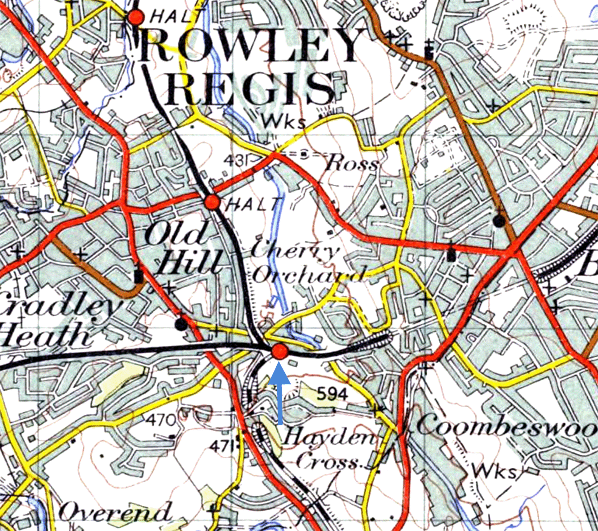

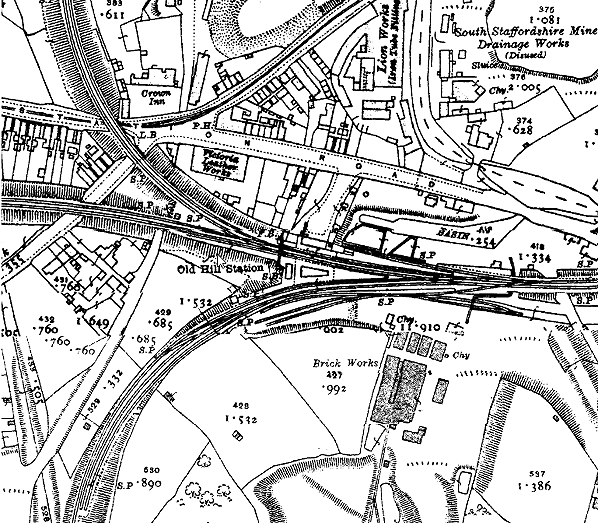

hill_old8.jpg) A Pressed Steel Class 116 DMU pauses at the down platform with a local service for Birmingham in September 1959. Note the station footbridge has had its canopy removed .
A Pressed Steel Class 116 DMU pauses at the down platform with a local service for Birmingham in September 1959. Note the station footbridge has had its canopy removed .hill_old17.jpg)
1.jpg)
hill_old13.jpg)
hill_old14.jpg) Looking towards Stourbridge from the up platform in the late 1960s the station has seen a serious rationalisation in passenger provision with not even a waiting shelter provided on the down platform. Old Hill Junction signal box is still standing proudly on the platform; it would be abolished on 25 March 1973.
Looking towards Stourbridge from the up platform in the late 1960s the station has seen a serious rationalisation in passenger provision with not even a waiting shelter provided on the down platform. Old Hill Junction signal box is still standing proudly on the platform; it would be abolished on 25 March 1973.hill_old15.jpg)
hill_old2.jpg)
hill_old3.jpg)

 In its efforts to reach industrial Birmingham, the WMR obtained an Act of Parliament to build a line from Stourbridge Junction to Old Hill, and within 12 months had obtained a second Act to complete the line from Old Hill to the London & North Western Railway’s (LNWR) Stour Valley line at Smethwick with an adjoining link to the Great Western Railway’s (GWR) line from Snow Hill to Wolverhampton Low Level near Handsworth. On 17 July 1862 the WMR Additional Works Act authorised the construction of two branches radiating from Old Hill. The first was to run in a northerly direction to Blowers Green Junction, near Dudley, and connect with the GWR’s Stourbridge Junction to Wolverhampton Low Level line. The second would run south to Halesowen with an end-on connection with the proposed Halesowen & Bromsgrove Branch Railway (HB&BR). On 1 August 1863 the WMR was amalgamated with the GWR: a shrewd move by the GWR as it would deny the LNWR access via Smethwick to Stourbridge and allow direct access to Birmingham. In the 1860s any trains from the Stourbridge direction wishing to access Birmingham had to travel via Dudley and reverse at Wolverhampton Low Level, substantially increasing the journey time.
In its efforts to reach industrial Birmingham, the WMR obtained an Act of Parliament to build a line from Stourbridge Junction to Old Hill, and within 12 months had obtained a second Act to complete the line from Old Hill to the London & North Western Railway’s (LNWR) Stour Valley line at Smethwick with an adjoining link to the Great Western Railway’s (GWR) line from Snow Hill to Wolverhampton Low Level near Handsworth. On 17 July 1862 the WMR Additional Works Act authorised the construction of two branches radiating from Old Hill. The first was to run in a northerly direction to Blowers Green Junction, near Dudley, and connect with the GWR’s Stourbridge Junction to Wolverhampton Low Level line. The second would run south to Halesowen with an end-on connection with the proposed Halesowen & Bromsgrove Branch Railway (HB&BR). On 1 August 1863 the WMR was amalgamated with the GWR: a shrewd move by the GWR as it would deny the LNWR access via Smethwick to Stourbridge and allow direct access to Birmingham. In the 1860s any trains from the Stourbridge direction wishing to access Birmingham had to travel via Dudley and reverse at Wolverhampton Low Level, substantially increasing the journey time. 
 departures on Monday-to-Saturday and 10 on a Sunday as shown in Bradshaw’s 1895 timetable. Having their own platform, Halesowen trains operated independently from those on the main line. On the other hand, services to Dudley via Windmill End would arrive at the main up platform and have to be switched to the main down platform without disrupting the intensive service between Stourbridge Junction and Birmingham. Freight seems not to have been a major concern for the GWR, although a trailing connection from the up main line was laid at the Birmingham end of the platform with a short siding laid close to the already well established canal basin. The yard never developed and the track into it was clearly out of use by the early 1950s.
departures on Monday-to-Saturday and 10 on a Sunday as shown in Bradshaw’s 1895 timetable. Having their own platform, Halesowen trains operated independently from those on the main line. On the other hand, services to Dudley via Windmill End would arrive at the main up platform and have to be switched to the main down platform without disrupting the intensive service between Stourbridge Junction and Birmingham. Freight seems not to have been a major concern for the GWR, although a trailing connection from the up main line was laid at the Birmingham end of the platform with a short siding laid close to the already well established canal basin. The yard never developed and the track into it was clearly out of use by the early 1950s. Rationalisation of the passenger service came on 5 December 1927 when the GWR withdrew the Halesowen trains; although all was not lost with two unadvertised workmen’s return trains to the Austin plant at Longbridge. It was not unknown for members of the public also to use the trains, which were eventually discontinued on 29 August 1958. Since 1 February that year the Halesowen branch had been transferred from British Railways Western Region to London Midland administration, although Old Hill station itself remained in the Western Region.
Rationalisation of the passenger service came on 5 December 1927 when the GWR withdrew the Halesowen trains; although all was not lost with two unadvertised workmen’s return trains to the Austin plant at Longbridge. It was not unknown for members of the public also to use the trains, which were eventually discontinued on 29 August 1958. Since 1 February that year the Halesowen branch had been transferred from British Railways Western Region to London Midland administration, although Old Hill station itself remained in the Western Region.  1957 when their fully flanged totem nameplates were installed; however they were fixed to elderly gas lamps of an elegant GWR design with slender metal scrolls above the lamp bracket. Platform seats bearing the earlier GWR logo on the supports continued to meet the needs of weary passengers. Some exquisite GWR running-in nameboards were retained into the 1960s; not content with giving the station’s name, they invited passengers to change for Halesowen, Windmill End branch and Dudley – despite the withdrawal of the regular Halesowen service over three decades earlier.
1957 when their fully flanged totem nameplates were installed; however they were fixed to elderly gas lamps of an elegant GWR design with slender metal scrolls above the lamp bracket. Platform seats bearing the earlier GWR logo on the supports continued to meet the needs of weary passengers. Some exquisite GWR running-in nameboards were retained into the 1960s; not content with giving the station’s name, they invited passengers to change for Halesowen, Windmill End branch and Dudley – despite the withdrawal of the regular Halesowen service over three decades earlier.
 passenger service was the withdrawal of the service to Dudley on 15 June 1964, as recommended in the ‘Beeching Report’ of March 1963. This was to have a massive impact on the station facilities. The first rationalisation was the demolition of the down (Stourbridge direction) platform buildings and the long, curving platform on the Halesowen branch. Passengers travelling south-west, to stations such as Cradley Heath, Lye or Stourbridge, were not even provided with a waiting shelter. The signal box on the down side survived until a re-signalling project in the early 1970s saw its abolition. The now shabby and neglected buildings on the up (Birmingham direction) platforms would also be demolished in the late 1960s, being replaced with a charmless, utilitarian single-storey building resembling a public convenience. Fluorescent electric lighting was also installed at that time, of the London Midland style at the time, with chunky lampshades. British Rail ‘Corporate Identity’ signage replaced the Western Region fittings, in the early form with large running-in boards and minuscule name tablets fixed to the lamp standards
.
Around this point the up and down platforms were rebuilt using modern breeze-block with new edging stones, and a tarmac surface replaced the GWR flagstones. The station has since been refurbished by Network West Midlands with the only surviving original structure - the footbridge - being removed and a new one constructed further up the platform towards Birmingham.
passenger service was the withdrawal of the service to Dudley on 15 June 1964, as recommended in the ‘Beeching Report’ of March 1963. This was to have a massive impact on the station facilities. The first rationalisation was the demolition of the down (Stourbridge direction) platform buildings and the long, curving platform on the Halesowen branch. Passengers travelling south-west, to stations such as Cradley Heath, Lye or Stourbridge, were not even provided with a waiting shelter. The signal box on the down side survived until a re-signalling project in the early 1970s saw its abolition. The now shabby and neglected buildings on the up (Birmingham direction) platforms would also be demolished in the late 1960s, being replaced with a charmless, utilitarian single-storey building resembling a public convenience. Fluorescent electric lighting was also installed at that time, of the London Midland style at the time, with chunky lampshades. British Rail ‘Corporate Identity’ signage replaced the Western Region fittings, in the early form with large running-in boards and minuscule name tablets fixed to the lamp standards
.
Around this point the up and down platforms were rebuilt using modern breeze-block with new edging stones, and a tarmac surface replaced the GWR flagstones. The station has since been refurbished by Network West Midlands with the only surviving original structure - the footbridge - being removed and a new one constructed further up the platform towards Birmingham. platforms, with staff in attendance, except on Sunday. A quick walk around the rear of the Stourbridge platform reveals a wealth of artefacts from the former buildings on the island platform. Numerous GWR flagstones are scattered around, with the locking room base of the signal box visible. Several gas pipes pop up out of the ivy-covered ground which probably supplied the signal box and main building. A signalling cubicle is slowly being devoured by the relentless growth of ivy, and two wooden posts in metal sheaths stand on the platform; they could have held a running-in board at some point. The casual traveller today would never realise what a busy and important junction station Old Hill had been and, although the signal box was called Old Hill Junction, the station never was.
platforms, with staff in attendance, except on Sunday. A quick walk around the rear of the Stourbridge platform reveals a wealth of artefacts from the former buildings on the island platform. Numerous GWR flagstones are scattered around, with the locking room base of the signal box visible. Several gas pipes pop up out of the ivy-covered ground which probably supplied the signal box and main building. A signalling cubicle is slowly being devoured by the relentless growth of ivy, and two wooden posts in metal sheaths stand on the platform; they could have held a running-in board at some point. The casual traveller today would never realise what a busy and important junction station Old Hill had been and, although the signal box was called Old Hill Junction, the station never was.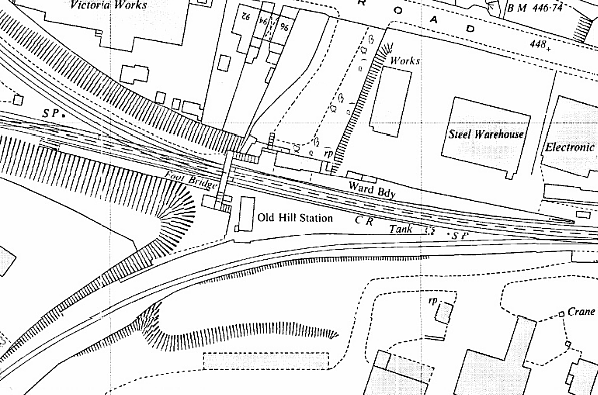
hill_old16.jpg)
.jpg)
hill_old1.jpg)

 Home Page
Home Page